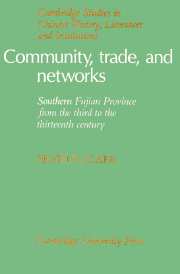Book contents
- Frontmatter
- Contents
- List of maps and tables
- Acknowledgments
- 1 Problems and approaches
- 2 The late Tang
- 3 The interregnum: politics, structure, and administration
- 4 The interregnum: society and economics
- 5 The Song: demography and networks
- 6 The Song: trade and economy
- 7 Conclusions
- Appendix 1 Townships (xiang), villages (li), and command brigades (dubao) under the Song
- Appendix 2 A discussion of population distribution
- Appendix 3 Pre-Song and Song bridges by district in twenty-five-year intervals
- Appendix 4 Place names in the Yunlu manchao and Zhufan zhi
- Appendix 5 Abbreviations
- Notes
- Glossary
- Bibliography
- Index
5 - The Song: demography and networks
Published online by Cambridge University Press: 13 October 2009
- Frontmatter
- Contents
- List of maps and tables
- Acknowledgments
- 1 Problems and approaches
- 2 The late Tang
- 3 The interregnum: politics, structure, and administration
- 4 The interregnum: society and economics
- 5 The Song: demography and networks
- 6 The Song: trade and economy
- 7 Conclusions
- Appendix 1 Townships (xiang), villages (li), and command brigades (dubao) under the Song
- Appendix 2 A discussion of population distribution
- Appendix 3 Pre-Song and Song bridges by district in twenty-five-year intervals
- Appendix 4 Place names in the Yunlu manchao and Zhufan zhi
- Appendix 5 Abbreviations
- Notes
- Glossary
- Bibliography
- Index
Summary
It was under the Song dynasty that Quannan evolved from a region on the empire's periphery into one of its most important parts. In the two and a half centuries from 978 to the early 1200s a pattern of demographic and economic growth came together to complete a transformation that had begun in the middle to late Tang. By the beginning of the thirteenth century Quannan was a densely settled area producing a variety of commercial goods – both agrarian and artisanal – destined for consumption in markets throughout China, the Southeast Asian archipelagoes, and the entire Indian Ocean littoral as far away as East Africa.
It would be misleading to consider the reincorporation of Quannan into a broader empire as a decisive dividing point; the evolution that led to the final transformation had not been interrupted by the interregnum. Indeed, I argue that the interregnum, because of the unique circumstances and responses it forced upon Quannan, was possibly indispensable to the transformation that was to occur. Nevertheless, reincorporation did occur and the subsequent evolution occurred in that context.
The establishment of the Song polity
The emergent Song dynasty arose out of the Five Dynasties of north China following the death of the Emperor Shizong of the Latter Zhou in 959. Zhao Kuangyin, the founding emperor, proclaimed his new dynasty in 960. Already the northern forces were girding themselves for campaigns against the several independent states of the South; Shizong had engaged in the series of wars against each of the states along the Yangtze River, although none had yet fallen.
- Type
- Chapter
- Information
- Community, Trade, and NetworksSouthern Fujian Province from the Third to the Thirteenth Century, pp. 71 - 119Publisher: Cambridge University PressPrint publication year: 1991



